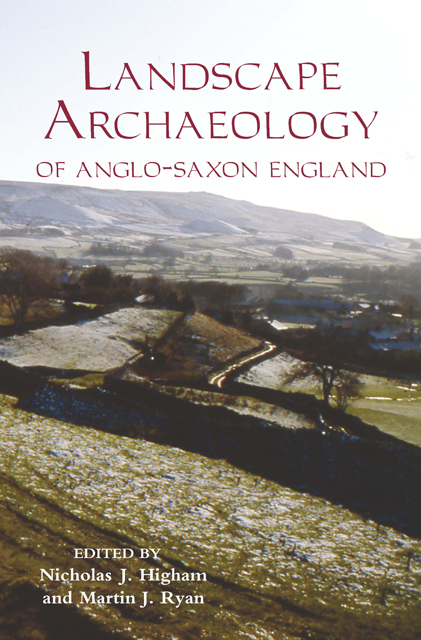Book contents
- Frontmatter
- Contents
- List of Illustrations
- Contributors
- Acknowledgements
- Abbreviations
- 1 The Landscape Archaeology of Anglo-Saxon England: An Introduction
- 2 Barriers to Knowledge: Coppicing and Landscape Usage in the Anglo-Saxon Economy
- 3 Landscape Change during the ‘Long Eighth Century’ in Southern England
- 4 Population Ecology and Multiple Estate Formation: The Evidence from Eastern Kent
- 5 Exploring Black Holes: Recent Investigations in Currently Occupied Rural Settlements in Eastern England
- 6 Medieval Field Systems and Settlement Nucleation: Common or Separate Origins?
- 7 The Environmental Contexts of Anglo-Saxon Settlement
- 8 Calendar Illustration in Anglo-Saxon England: Realities and Fictions of the Anglo-Saxon Landscape
- 9 The Anglo-Saxon Plough: A Detail of the Wheels
- 10 ‘In the Sweat of thy Brow Shalt thou eat Bread’: Cereals and Cereal Production in the Anglo-Saxon Landscape
- 11 The Early Christian Landscape of East Anglia
- 12 The Landscape and Economy of the Anglo-Saxon Coast: New Archaeological Evidence
- Index
7 - The Environmental Contexts of Anglo-Saxon Settlement
Published online by Cambridge University Press: 16 February 2023
- Frontmatter
- Contents
- List of Illustrations
- Contributors
- Acknowledgements
- Abbreviations
- 1 The Landscape Archaeology of Anglo-Saxon England: An Introduction
- 2 Barriers to Knowledge: Coppicing and Landscape Usage in the Anglo-Saxon Economy
- 3 Landscape Change during the ‘Long Eighth Century’ in Southern England
- 4 Population Ecology and Multiple Estate Formation: The Evidence from Eastern Kent
- 5 Exploring Black Holes: Recent Investigations in Currently Occupied Rural Settlements in Eastern England
- 6 Medieval Field Systems and Settlement Nucleation: Common or Separate Origins?
- 7 The Environmental Contexts of Anglo-Saxon Settlement
- 8 Calendar Illustration in Anglo-Saxon England: Realities and Fictions of the Anglo-Saxon Landscape
- 9 The Anglo-Saxon Plough: A Detail of the Wheels
- 10 ‘In the Sweat of thy Brow Shalt thou eat Bread’: Cereals and Cereal Production in the Anglo-Saxon Landscape
- 11 The Early Christian Landscape of East Anglia
- 12 The Landscape and Economy of the Anglo-Saxon Coast: New Archaeological Evidence
- Index
Summary
Introduction
It has become unfashionable in recent decades to seek to explain spatial patterns in the archaeological or historical record – whether distributions of artefacts or particular social or religious practices, on the one hand, or patterns of farming or settlement, on the other – in terms of environmental influences. Indeed, such approaches are castigated by many archaeologists as ‘environmental determinism’ and, in a discipline strongly influenced by post-modern and post-processual approaches, viewed as a negation of individual ‘choice’, and thus of the essential humanity of the past peoples whose lives it is our task to study. Instead, patterns in the data are generally viewed as representing shared lifestyles which were effectively the consequence of elective choice, the boundaries of which were essentially arbitrary in character. The limits of the ‘central province’ – that area of medieval England characterised by nucleated villages and regular open-field systems – have thus been interpreted as the edges of a zone where a ‘fashion’ for a particular mode of agrarian organisation simply petered out; while, at a more detailed level, the particular characteristics of the Whittleswood landscape have been attributed to the cumulative consequences of numerous individual decisions, with boundaries again largely unrelated to any other, non-social factors.
This assertion of the primacy, or even autonomy, of the social is not in itself new. An older generation interpreted many past spatial patterns as signifying the settlement areas of particular ethnic groups, which had maintained and perpetuated traditions and practices forged elsewhere when they came to live in new regions with very different environmental characteristics. Howard Gray for example saw the distribution of different kinds of field system and settlement pattern in medieval England largely as the consequence of variations in the intensity of Anglo-Saxon or Danish settlement; the predominance of free tenures in eastern England at the time of Domesday has often been seen as a result of Danish settlement in the ninth of tenth centuries; while spatial variations in early Anglo-Saxon burial practices, and in the distribution of dress fittings, have since the time of Leeds been interpreted as a reflection of the settlement areas of Bede's ‘three powerful nations’ of the Angles, Saxons and Jutes.
- Type
- Chapter
- Information
- The Landscape Archaeology of Anglo-Saxon England , pp. 133 - 156Publisher: Boydell & BrewerPrint publication year: 2010

